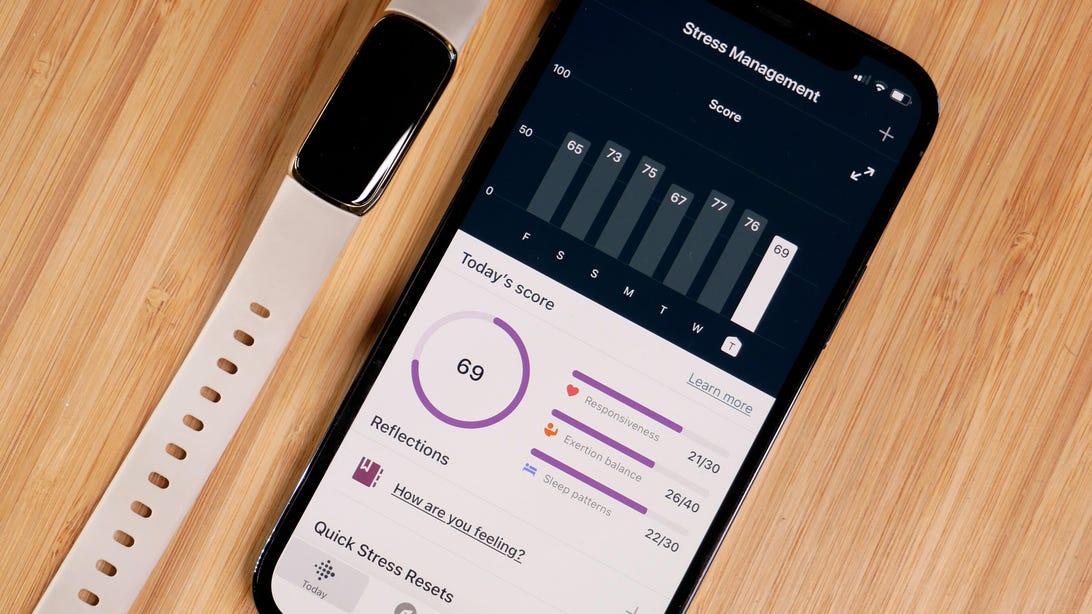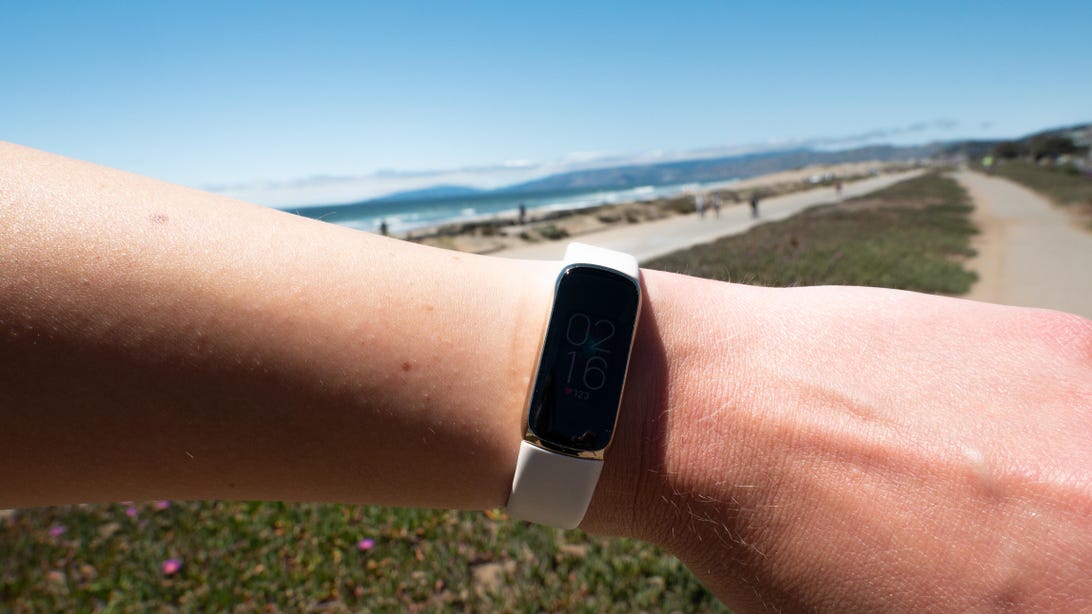Fitbit Luxe review: A tiny fitness tracker that punches above its weight
Fitbit is stepping up its fashion game with the Luxe, a slim fitness tracker that could pass for jewelry. The $150 Luxe offers many of Fitbit’s best health and fitness features, like sleep tracking and goal-based workouts, in a wearable designed for smaller wrists. But it faces competition from Fitbit’s own less expensive band-based trackers like the Inspire 2 and Charge 4 that have longer battery life and similar (or extra) features, even if they don’t look as good.
There’s been a gap in the market for fashionable trackers that a few wearables have tried to fill, like the Garmin Lily or the (much) more expensive Apple Watch Hermes. The Luxe feels like it takes a little of both and tries to be a crossover device. You get a good-looking fitness band, but you also get a daily health coach if you want it, too. The Luxe is best seen as a fashion-ready variant of the Inspire 2, maybe, with a nicer screen, but it’s not Fitbit’s best tracker for the price.
Like
- Sleek, lightweight tracker that looks like jewelry
- Same fitness, sleep and stress tracking as other Fitbits
- More than 5 days’ battery life
Don’t Like
- Screen and text may be too small for some people
- Buttonless navigation can be confusing
- No music controls
Luxe style at a luxe price
The Luxe has a stainless steel frame that makes it look chic even when worn with the standard silicone band. But the big drawcard is pairing it with other metal or leather bands to really make this feel more like a fashion accessory. The Gorjana stainless steel link bracelet is $100 and some of the leather straps cost between $50-$70. (If you are interested in the link bracelet, I’d suggest buying it in the bundle with the tracker to save $50.)
Even with the nicer looking bands, the Luxe is incredibly comfortable to wear. I’d go so far as to say it’s the most “invisible” Fitbit I’ve worn in recent years because I almost forget I’m wearing it. It’s slim and doesn’t get in the way during sleep. Plus, you won’t have to take it off for over five days because the battery lasts that long.

Lexy Savvides/CNET
But it is pretty small, so it won’t suit all wrists. The color AMOLED touchscreen is really nice to look at, although if you struggle reading small text you may have difficulty reading your stats without glasses. In broad daylight I could make out the screen when checking the time or my workout stats, but the ambient light sensor is a little slow to kick in to boost the brightness to max.
Unlike other Fitbit trackers, there aren’t any physical buttons on the Luxe, so you navigate entirely using the touchscreen. Double tap on the screen to go back, or swipe right on most screens to get back to the clock face. It’s a bit confusing and I’ve definitely started many accidental workouts just by trying to go back and check the time.
Health and well-being tracking is what you’re here for
Fitbit’s sleep tracking is excellent. After you wear the Luxe to bed, you’ll get a sleep score out of 100 in the morning that takes into account the quality of your rest. On top of the breakdown of time spent in different sleep zones — REM, light and deep — the Luxe also tracks metrics like breathing rate, resting heart rate and skin temperature variation at night. This is the same as found on more expensive Fitbits like the Versa 3 and Sense, with the Fitbit app providing a comprehensive breakdown of what each metric means. The Luxe will soon get blood oxygen (SpO2) tracking at night, too.

Your nightly sleep score in the Fitbit app.
Lexy Savvides/CNET
Stress tracking works in a similar way to sleep tracking, but isn’t as mature yet. First seen on the Fitbit Sense, stress management on the Luxe gives you a daily score out of 100 after having worn the tracker continuously for a few days. It’s calculated by looking at your sleep quality, overall activity level and responsiveness in a similar way to the Sense, but that watch also takes into account readings from an electrodermal activity (or EDA) sensor.
At first, I found the stress management score a bit confusing. I wasn’t sure what to do with it and the lower the score, the less stressed I thought I was supposed to be. It’s actually the reverse: a higher number is better. But now I like to think about my stress management score less about the word stress, but more as an indicator of my readiness. If I get a low score, I’ll take it easy and take a rest day or maybe try a meditation session to help improve my sleep. A higher score means I should be ready to push myself on a workout. Over time, you may be able to use the score as a bit of a benchmark and see how mindfulness activities could affect it (and hopefully how you feel, too). I’m still not sold on it being a must-have feature for me, but I’m excited to see how it evolves with time. The stress management score is also available on other Fitbit devices like the Versa series, Charge 4 and Inspire 2.

The stress management score shows up daily in the Fitbit app.
Lexy Savvides/CNET
The key to unlocking more insight into these mysterious scores and metrics is Fitbit Premium, the $10 monthly subscription service that offers everything from workout programs to meditation sessions and even eating programs. But you also get deeper insights into sleep, stress and trends on the health metrics dashboard. A six-month trial is included with the Luxe, which I think is the right amount of time to work out if this is worth the ongoing investment. As a data geek, the additional detail on sleep is the most valuable part to me, but for first-timers to the world of Fitbit, guided workouts or even Deepak Chopra’s Mindful Method may be more tempting. You could use these videos in conjunction with the guided breathing app on the Luxe, too.
The Luxe also comes with menstrual tracking and the option to log blood glucose levels in the Fitbit app.
The same great Fitbit fitness tracking, but without GPS
Fitness tracking on the Luxe works in a similar way to recent Fitbits. There are 20 workout types, although the Luxe can only store six at a time. Use the app to swap workouts in and out of those slots. Goal-based workouts are available, so you’ll get an alert if you hit a set calorie, distance or Active Zone Minute goal for example. Active Zone Minutes are Fitbit’s way of calculating moderate to intense physical activity and is supposed to be a more accurate representation of your fitness compared to steps alone. You’ll also be able to see your cardio fitness score (or VO2 Max) in the Fitbit app.
The Luxe is also water resistant up to 50 meters (164 feet) so there won’t be any issue using it while swimming. That said, I’m not sure how the more decorative bands will hold up with water contact, so probably best to stick to the silicone band.

The screen is visible in bright sunlight, but it doesn’t show up as well on camera.
Lexy Savvides/CNET
Due to its small size, the Luxe misses out on built-in GPS. Instead, it relies on connected GPS which means you’ll need to take your phone on any outdoor workout to track route information. Fitbit’s probably not expecting runners or cyclists like me to gravitate toward the Luxe for outdoor workouts (there’s the Charge 4 for that) but it’s still a feature I miss if I’m looking for a do-it-all tracker. For what it’s worth, the connected GPS locked on quickly when starting a workout.
I tested the heart rate sensor on the Luxe against a chest strap, the gold standard for consumer heart rate tracking. My resting heart rate on the Luxe matched up well, though during a cardio workout like a brisk walk or run, the heart rate sensor did lag behind the strap several seconds. This is not unusual for optical sensors worn on the wrist, but you may want to consider a more run-specific tracker or smartwatch if you need that precise heart rate on the watch face during your run.
You won’t get many smart features on the Luxe
The Luxe isn’t supposed to take the place of a smartwatch. It does the basics: alarms, timers, seeing incoming calls and notifications from your iPhone or Android. Notification replies with quick responses can only be sent from your wrist when paired with Android. But that’s about it. If you want music control, Fitbit Pay for mobile payments, or elevation tracking, look at another Fitbit. The Luxe doesn’t have them. You can swap out watch faces in the Fitbit app, though the selection isn’t as extensive as some of Fitbit’s other smartwatches.

Some of the watch faces on the Luxe.
Lexy Savvides/CNET
This is Fitbit’s first wearable since being acquired by Google, but there aren’t many clues as to what’s coming next for this integration. The Fitbit app still looks and acts the same as for previous devices. There’s a fast pairing mode when using Android, but that’s about it. We’ll need to wait and see what Fitbit features will end up included in Google’s new Wear OS watches.
Style and substance, but it’s not a one-size-fits-all tracker
After almost two weeks with the Fitbit Luxe, I really enjoy wearing it. But I’m not entirely sure who it’s for. Unless you’re specifically looking for a pretty fitness band with a color AMOLED screen (and are prepared to spend $200 to get that jewelry-like look), the cheaper Inspire 2 or Charge 4 offer most of the same features as the Luxe for less. You could even elevate the look of those trackers with metal bands if you wanted to make them fancier. But it’s really nice to have more options for those of us with smaller wrists, and the Luxe is a welcome addition to the growing arena of fashionable fitness watches.








